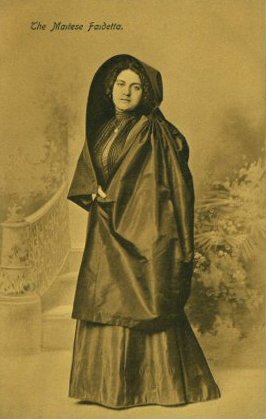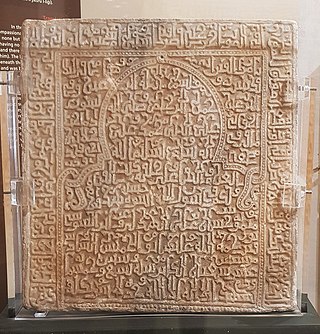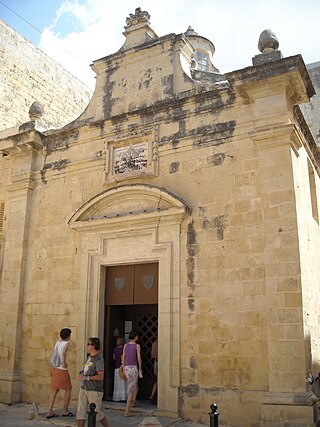
Żejtun is a city in the South Eastern Region of Malta, with a population of 11,218 in the end of 2016. Żejtun is traditionally known as Città Beland, a title conferred by the grandmaster of the Order of the Knights of Malta, Ferdinand von Hompesch zu Bolheim in 1797. Before that, the village was known as Casale Santa Caterina, named after its patron saint and parish titular.
Għana is a type of traditional Maltese folk music. Għana has two literal meanings. The first is richness, wealth and prosperity; the second is associated with singing, verse, rhyme and even kantaliena, a type of singing with a slow rhythm. Għana can be broken up into formal and informal practices. The origin of the word is Arabic Ghena or Ghina غنى/غناء which means the same : richness or singing/songs/lyrics, etc...

The għonnella[oˤːnˈnɛl.lə], sometimes referred to as a Faldetta, is a form of women's head dress and shawl, or hooded cloak, unique to the Mediterranean islands of Malta and Gozo. There was an alternative blue version in the south-east of Malta, and it was referred to as xurqana. Another in the village of Għargħur was referred to as stamijna.

Luke Anthony Dimech is a former Maltese professional footballer defender.

Ian Azzopardi is a Maltese footballer who currently plays for Maltese Premier League side Senglea Athletic, where he plays as a defender.
Adrian Ciantar is a footballer who is currently without a club

Mtarfa F.C. is a football club from Mtarfa, the home of a former big British forces barracks area in central Malta. Founded in 2006, the club took part for the first time in their history in the 2007/2008 season. They entered the Malta Football Association in lieu of Ta' Xbiex S.C., who lost their status due consistently poor results in the lowest of Maltese divisions. They currently play in the Maltese National Amateur League B. They also play in the annual Maltese FA Trophy.
The Golden Calf of Gozo is a golden statue of a calf that was supposedly discovered buried under the Hill of Ta' Gelmus in 1729 on the island of Gozo, Malta. It was supposedly brought by Jewish refugees from the destruction of Jerusalem and buried by expelled Jews around 1494, before they left the island. Whether it was the original Golden Calf is open to interpretation.

The Cippi of Melqart are a pair of Phoenician marble cippi that were unearthed in Malta under undocumented circumstances and dated to the 2nd century BC. These are votive offerings to the god Melqart, and are inscribed in two languages, Ancient Greek and Phoenician, and in the two corresponding scripts, the Greek and the Phoenician alphabet. They were discovered in the late 17th century, and the identification of their inscription in a letter dated 1694 made them the first Phoenician writing to be identified and published in modern times. Because they present essentially the same text, the cippi provided the key to the modern understanding of the Phoenician language. In 1758, the French scholar Jean-Jacques Barthélémy relied on their inscription, which used 17 of the 22 letters of the Phoenician alphabet, to decipher the unknown language.
Suor Maria de Dominici was a Maltese painter, sculptor, and a Carmelite tertiary nun. Born into a family of artists based in the city of Birgu (Vittoriosa), she was the daughter of a goldsmith and appraiser for the Knights of Malta. Two of her brothers, Raimondo de Dominici and Francesco de Dominici, were painters. Raimondo's son Bernardo would write a contemporary art history book that included references to his aunt Maria.

Whittlesea Ranges is a professional soccer club based in the suburbs of Epping and Lalor, Victoria, Australia. All home games are played at Epping Stadium.

Christopher Fearne is a Maltese physician and politician. He was appointed Parliamentary Secretary for Health in April 2014 and Minister for Health since April 2016. In July 2017, the Labour Party elected him as Deputy Leader for Parliamentary Affairs, thus assuming the role of Deputy Prime Minister of Malta and Leader of the House.

The Church of the Flight into Egypt is a Roman Catholic church located at the Valletta Waterfront in Floriana, Malta. The church was built in the 18th-century on the baroque design of Andrea Belli for spiritual service of the workers at the Pinto Stores. The church was hit by aerial bombardment in World War II in 1941 and it was then restored in 1989 but it remained unconsecrated. It was opened for church service again in 2006 together with the Valletta Waterfront. The current rector is Paul Attard.

Għajn Żnuber Tower, also known as Ta' Ciantar Tower, is a rural structure in the limits of Mellieħa, Malta. It was likely built in the 19th century as a farmstead or hunting lodge, and it later served as an anti-smuggling post and a coastal lookout position. The building was restored in 2012 after part of it had collapsed, and it is now a visitor centre of Il-Majjistral Nature and History Park.

The Maymūnah Stone is a 12th-century marble tombstone which is believed to have been discovered in Xewkija, Gozo, Malta. According to judge and historian Giovanni Bonello, the Majmuna Stone is a "spectacular visual relic of the Islamic presence in Malta." It is now exhibited in the Gozo Museum of Archaeology at the Cittadella of Victoria, Gozo.

The Chapel of St Agatha is a small Roman Catholic church located in the medieval city of Mdina, Malta.

Għar Qawqla is a limestone formation located off Marsalforn on the island of Gozo in Malta. It was formerly a natural arch connected to the mainland, but the span collapsed at some point during the 20th century. It has been speculated that the name Marsalforn might be partially derived from forna, referring to the natural sea caves of the area, of which Għar Qawqla was one of the best-known. The formations stands about 7.9 metres (26 ft) off the shore.

The Benhisa inscription, CIS I 124, is Punic funeral inscription found in Malta in 1761. It mentions the name Hannibal, which garnered significant scholarly interest.















